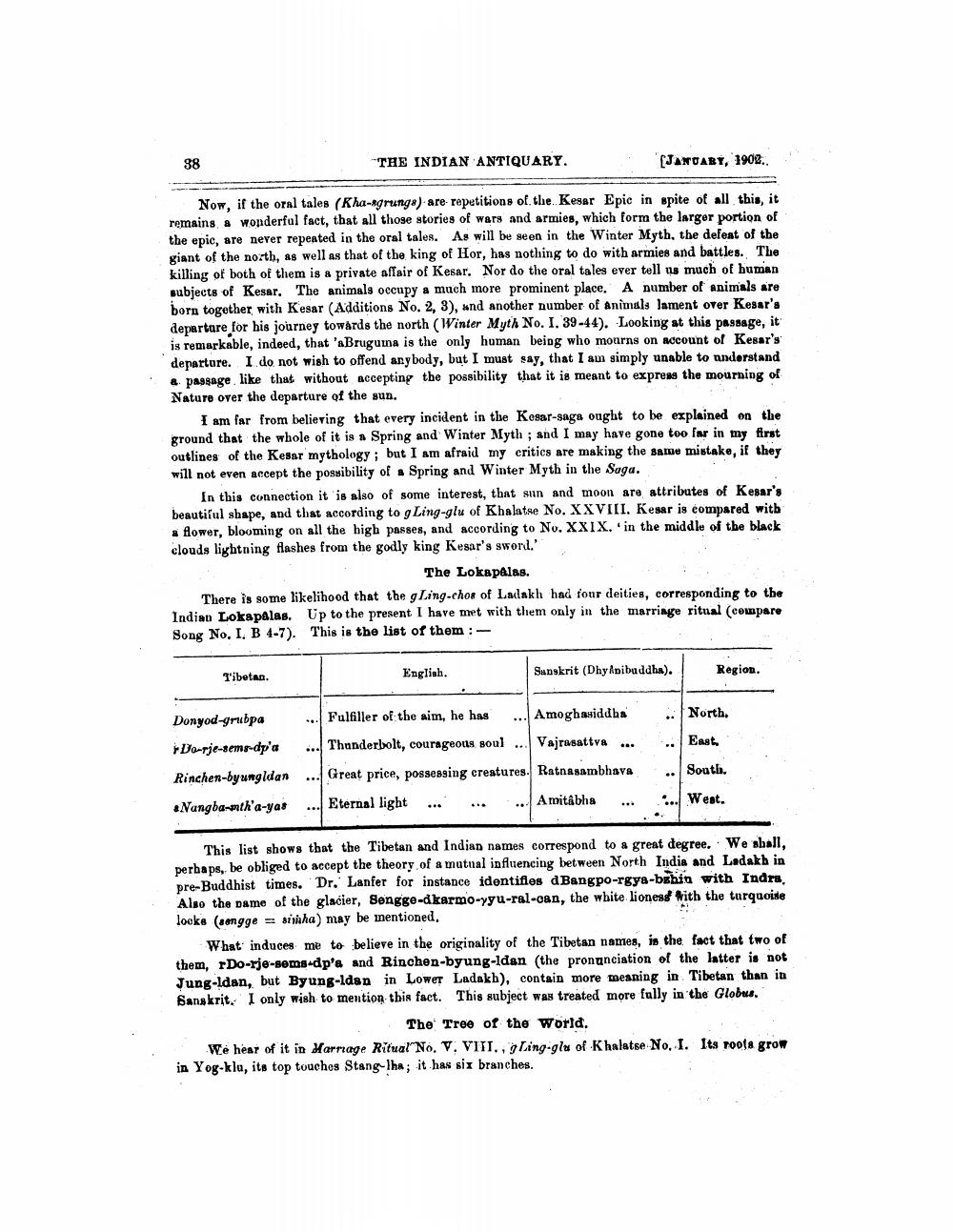________________
88
THE INDIAN ANTIQUARY.
[JANUARY, 1902...!
Now, if the oral tales (Kha-ngrungs) are repetitions of the Kesar Epic in spite of all this, it remains a wonderful fact, that all those stories of wars and armies, which form the larger portion of the epic, are never repeated in the oral tales. As will be seen in the Winter Myth, the defeat of the giant of the north, as well as that of the king of Hor, has nothing to do with armies and battles. The killing of both of them is a private affair of Kesar. Nor do the oral tales ever tell us much of human subjects of Kesar. The animals occupy a much more prominent place. A number of animals are born together with Kesar (Additions No. 2, 3), and another number of animals lament over Kesar's departure for his journey towards the north (Winter Myth No. I. 39-44). Looking at this passage, it is remarkable, indeed, that 'a Bruguma is the only human being who mourns on account of Kesar's departore. I do not wish to offend any body, but I must say, that I am simply unable to understand & paggage like that without accepting the possibility that it is meant to express the mourning of Nature over the departure of the sun.
I am far from believing that every incident in the Kesar-saga ought to be explained on the ground that the whole of it is a Spring and Winter Myth ; and I may have gone too far in my first outlines of the Kesar mythology; but I am afraid my critics are making the same mistake, if they will not even accept the possibility of a Spring and Winter Myth in the Saga.
In this connection it is also of some interest, that sun and moon are attributes of Kesar's beautiful shape, and that according to g Ling-glu of Khalatse No. XXVIII. Kesar is compared with #flower, blooming on all the high passes, and according to No. XXIX. in the middle of the black clouds lightning flashes from the godly king Kesar's sword.'
The Lokapalas. There is some likelihood that the g Ling-chor of Ladakh had four deities, corresponding to the Indian Lokapalas. Up to the present I have met with them only in the marriage ritual (compare Song No. I. B 4-7). This is the list of them :
Tibetan.
English.
Sanskrit (Dhy Anibuddha).
Region.
North. East,
..
Donyod-grubpa
Da-rje-sems-dp'a Rinchen-byungidan #Nangba-nth'a-yat
Fulfiller of the sim, he has ... Amoghasiddha ... Thunderbolt, courageous soul ... Vajrasattva ... ... Great price, possessing creatures. Ratnasambhava ... Eternal light ... ... ... Amitabha ...
South.
... West.
This list shows that the Tibetan and Indian names correspond to a great degree. We sball, perhaps, be obliged to accept the theory of a mutual influencing between North India and Ladakh in pre-Buddhist times. Dr. Lanfer for instance identifies d Bangpo-rgya-behin with Indra, Also the name of the glacier, Sengge-dkarmo-ygu-ral-can, the white lioness with the turquoise loeke (songge = siniha) may be mentioned,
What induces me to believe in the originality of the Tibetan names, is the fact that two of them, Do-rje-sems-dp'a and Rinchen-byung-ldan (the pronunciation of the latter is not Jung-Idan, but Byung-ldan in Lower Ladakh), contain more meaning in Tibetan than in Sanskrit. I only wish to mention this fact. This subject was treated more fully in the Globus.
The Tree of the world. We hear of it in Marriage Ritual No. V. VIII., Ling-glu of Khalatse No. 1. Its roots grow in Yog-kla, its top touches Stang-lhe; it has six branches.




